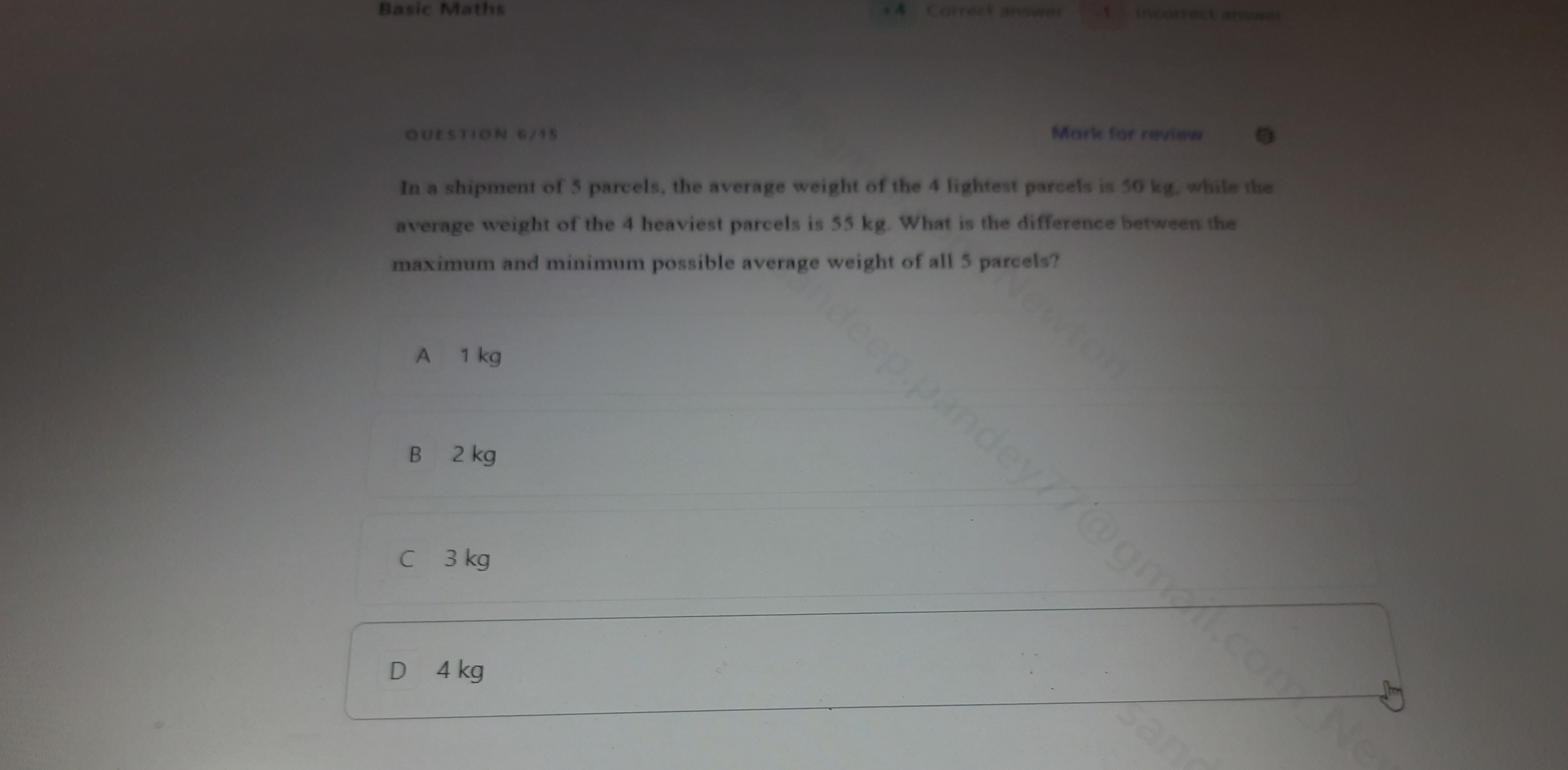Question
Question: In a shipment of 5 parcels, the average weight of the 4 lightest parcels is 50 kg, while the average...
In a shipment of 5 parcels, the average weight of the 4 lightest parcels is 50 kg, while the average weight of the 4 heaviest parcels is 55 kg. What is the difference between the maximum and minimum possible average weight of all 5 parcels?

1 kg
2 kg
3 kg
4 kg
3 kg
Solution
Let the weights of the 5 parcels be w1,w2,w3,w4,w5 in ascending order, so w1≤w2≤w3≤w4≤w5.
The average weight of the 4 lightest parcels is 50 kg. The 4 lightest parcels are w1,w2,w3,w4. So, 4w1+w2+w3+w4=50. The sum of the weights of the 4 lightest parcels is SL=w1+w2+w3+w4=4×50=200 kg.
The average weight of the 4 heaviest parcels is 55 kg. The 4 heaviest parcels are w2,w3,w4,w5. So, 4w2+w3+w4+w5=55. The sum of the weights of the 4 heaviest parcels is SH=w2+w3+w4+w5=4×55=220 kg.
Let S5 be the sum of the weights of all 5 parcels: S5=w1+w2+w3+w4+w5. We can write S5=(w1+w2+w3+w4)+w5=SL+w5=200+w5. We can also write S5=w1+(w2+w3+w4+w5)=w1+SH=w1+220.
Equating the two expressions for S5, we get 200+w5=w1+220. This gives the relationship between the heaviest and lightest parcel: w5−w1=220−200=20.
The average weight of all 5 parcels is A5=5S5=5200+w5=5w1+220. To find the range of A5, we need to find the range of possible values for w1 or w5.
We know the weights are sorted: w1≤w2≤w3≤w4≤w5. From w1+w2+w3+w4=200, since w1≤w2≤w3≤w4, we have 4w1≤w1+w2+w3+w4=200, which implies w1≤50. Also, w1+w2+w3+w4≤w4+w4+w4+w4=4w4, so 200≤4w4, which implies w4≥50.
From w2+w3+w4+w5=220, since w2≤w3≤w4≤w5, we have 4w2≤w2+w3+w4+w5=220, which implies w2≤55. Also, w2+w3+w4+w5≤w5+w5+w5+w5=4w5, so 220≤4w5, which implies w5≥55.
We have the constraints:
- w1≤w2≤w3≤w4≤w5
- w1+w2+w3+w4=200
- w2+w3+w4+w5=220 From (3) - (2), w5−w1=20, so w5=w1+20.
Substitute w5=w1+20 into (1): w1≤w2≤w3≤w4≤w1+20.
To find the minimum possible average weight A5,min, we need to minimize w1. Consider the sum w1+w2+w3+w4=200. Since w2≤w3≤w4≤w1+20, we have w2+w3+w4≤3(w1+20). w1+(w2+w3+w4)=200. w1+w2+w3+w4=200. Since w1≤w2≤w3≤w4, we have w4≥w1. Also, w4≤w1+20. From w1+w2+w3+w4=200, we have w1=200−(w2+w3+w4). To minimize w1, we need to maximize w2+w3+w4. We know w2≤w3≤w4 and w4≤w1+20. The maximum value of w4 is w1+20. The maximum values of w2,w3 are limited by w4. Consider the case where w2=w3=w4=w1+20. Then w1+3(w1+20)=200. w1+3w1+60=200. 4w1=140. w1=35. In this case, w1=35, w2=35+20=55, w3=55, w4=55, w5=w1+20=35+20=55. The weights are 35, 55, 55, 55, 55. Let's check the conditions: Sorted: 35 ≤ 55 ≤ 55 ≤ 55 ≤ 55. Yes. Average of 4 lightest (35, 55, 55, 55): 435+55+55+55=4200=50. Yes. Average of 4 heaviest (55, 55, 55, 55): 455+55+55+55=4220=55. Yes. This is a valid set of weights. The sum is 35+55+55+55+55=255. The average is 5255=51. This corresponds to the minimum possible value of w1, which is 35. Minimum sum S5,min=220+w1,min=220+35=255. Minimum average A5,min=5255=51.
To find the maximum possible average weight A5,max, we need to maximize w1. Consider the sum w1+w2+w3+w4=200. Since w1≤w2≤w3≤w4, to maximize w1, we need to make w2,w3,w4 as close to w1 as possible. Consider the case where w1=w2=w3=w4. Then w1+w1+w1+w1=200, so 4w1=200, w1=50. In this case, w1=50, w2=50, w3=50, w4=50. Then w5=w1+20=50+20=70. The weights are 50, 50, 50, 50, 70. Let's check the conditions: Sorted: 50 ≤ 50 ≤ 50 ≤ 50 ≤ 70. Yes. Average of 4 lightest (50, 50, 50, 50): 450+50+50+50=4200=50. Yes. Average of 4 heaviest (50, 50, 50, 70): 450+50+50+70=4220=55. Yes. This is a valid set of weights. The sum is 50+50+50+50+70=270. The average is 5270=54. This corresponds to the maximum possible value of w1, which is 50. Maximum sum S5,max=220+w1,max=220+50=270. Maximum average A5,max=5270=54.
The range of possible average weights is from 51 kg to 54 kg. The difference between the maximum and minimum possible average weight is A5,max−A5,min=54−51=3 kg.
The final answer is 3kg.
